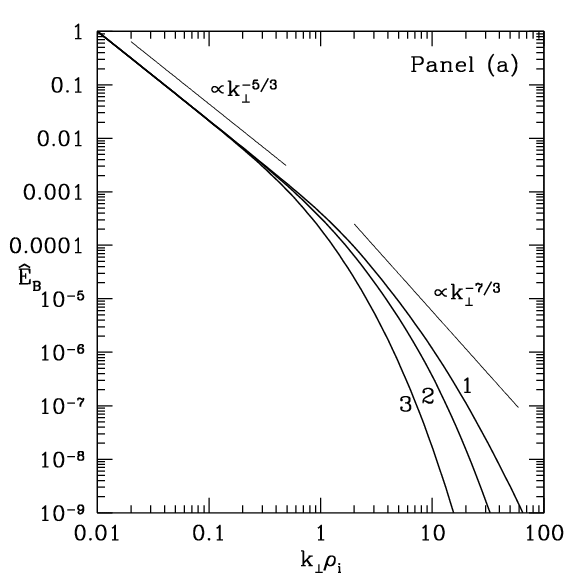Analytical Models
Simple analytical models provide an important tool for deconstructing the mechanisms underlying complex physical processes, for interpreting numerical simulations and, for making connections to observational or laboratory data. This analytical modeling component of my research program at the University of Iowa provides an overarching theoretical framework for my studies of kinetic plasma turbulence.
Cascade Model for Kinetic Turbulence
In our recent work, A Model of Turbulence in Magnetized Plasmas: Implications for the Dissipation Range in the Solar Wind, published in The Journal of Geophysical Research-Space Physics, my collaboration constructed a simple analytical model for the turbulent cascade of energy in kinetic plasmas. This cascade model is based on three assumptions:
- The Kolmogorov hypothesis of local nonlinear energy transfer in wavenumber space.
- Critical Balance between linear propagation and nonlinear interaction times.
- The applicability of linear dissipation rates for the nonlinearly turbulent plasma.

|
Above is plotted the magnetic energy spectrum predicted by this cascade model for a variety of plasma conditions (traces 1, 2, and 3)—see our published paper for more details.
The predictions of this cascade model imply that collisionless damping provides a natural explanation for the observed range of spectral indices in the dissipation range of the solar wind. The dissipation range spectrum is predicted to be an exponential fall off; the power-law behavior apparent in observations may be an artifact of limited instrumental sensitivity.
Thermodynamic Model of the Solar Wind
Along with Eliot Quataert of the Department of Astronomy at UC Berkeley, I have been developing a thermodynamic model of the solar wind to establish the importance of temperature anisotropy instabilities and provide constraints on the plasma heating due to the kinetic dissipation of turbulence in the solar wind. Look for more details soon on this exciting work in progress.